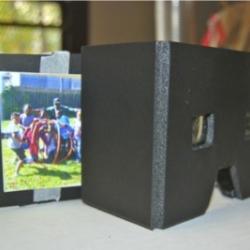Source Institutions
Source Institutions
Add to list Go to activity

In this activity, learners construct a device that allows them to view 2-D images in 3-D. These 2-D stereoscopic images are simply pictures of the same thing, taken from two positions some distance apart. A stereoscope fools the brain into “seeing” a 3-dimensional image, by using two 2-dimensional images that are slightly different. The brain takes the 2D images provided by each eye, and blends them to make one image with depth – a 3D image. [Activity is publicly available through a web crawler capture on Archive.org.]
- 10 to 30 minutes
- 1 to 2 hours
- Over $20 per student
- Ages 6 - 11
- Activity, Lesson/Lesson Plan
- English
Quick Guide
Materials List (per student)
- 2 80-mm focal length plano-convex lenses
- dark cardboard or foam core
- stereoscope images
- pencil
- string
- scissors
- ruler
- hot glue gun
- utility knife
- tape
Subjects
-
Engineering and Technology
- Technology
-
Life Sciences
-
Human Body
- The Brain and Nervous System
-
Human Senses and Perception
- Vision
- Perception
-
Human Body
-
Mathematics
-
Geometry
- Plane Geometry
-
Geometry
-
Physical Sciences
-
Vibration and Waves
- Light and Optics
-
Light and Optics
- Lenses and Mirrors
-
Vibration and Waves
-
The Nature of Science
-
The Scientific Process
- Conducting Investigations
-
The Scientific Process
Informal Categories
- Photography and Film/Video
- Toys
Audience
To use this activity, learners need to:
- see
- touch
Learning styles supported:
- Links STEM to other topics of interest such as arts and humanities
- Involves hands-on or lab activities
Other
Includes alignment to state and/or national standards:
This resource is part of:
Access Rights:
- Free access
By:
- Oakland Discovery Centers
Rights:
- All rights reserved, Oakland Discovery Centers, 2011
